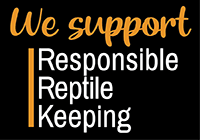When should I not utilize a bioactive habitat for my reptiles or amphibians?

When NOT to Go Bioactive
Written by Mariah Healey, ReptiFiles.com
Bioactive can be an amazing way to keep reptiles, with many benefits! Bioactive enclosures help maintain higher levels of humidity for tropical species, and can also help prevent dehydration in semi-arid species. They can promote better air quality, stronger immune systems, and better mental wellbeing for your pet. They’re also “lower-maintenance” in terms of chores like routine substrate replacements and total cleanouts.
That said, bioactive is not the only way to do reptile husbandry well, and it’s not without faults and weaknesses. If you’re considering setting up a bioactive reptile enclosure (or you already have one), here are 4 scenarios in which it’s best to actually delay or step away from bioactive keeping:
- Your Pet is Sick
If you’re rehabilitating a sick reptile or you’ve taken on a rescue, don’t toss it in a bioactive setup right away. This can contaminate your ecosystem, make it difficult to track the reptile’s health (such as gathering fecal samples), and/or slow recovery. A compromised immune system is less able to deal with the bacteria which naturally occur in a natural environment, even in a healthy and thriving setup.
This also applies to new additions to your home — a new reptile, even from a trusted source, should be treated like a sick animal until proven otherwise. Use a quarantine/hospital setup until the reptile is stable and healthy, then you can introduce it to a bioactive enclosure or back into its previous setup.
- Your Pet is Injured
If your pet is injured — whether because it’s recovering from surgery or had an accident — it’s important to keep the wound as clean as possible. The wound needs to be kept as clean as possible in order to heal well, and this is difficult to do in a setup full of dirt. Furthermore, due to the presence of naturally-occurring bacteria mentioned above, there is a possibility for secondary infection to set in via the compromised skin barrier.
An exception to this are geckos and other lizard species which naturally drop their tails, such as leopard geckos and crested geckos. These “wounds” heal in a unique way that shouldn’t be complicated by the presence of organic matter in their environment.
- You Are Using a Temporary Enclosure
Using your enclosure as a grow-out setup for a juvenile? Planning to upgrade in the next few years? If the enclosure you want to establish as bioactive is intended to be used on a temporary basis, then it’s best to stick with disposable substrates and routine cleanouts for now. Bioactive is supposed to be a long-term housing approach where you build, establish, and maintain a miniature ecosystem. It’s a waste to go through all the trouble of setting that up for something you’ll have to demolish relatively soon, as bioactive setups should never be re-used for another animal.
If you move frequently or know you will be moving in the near future, this can apply to you as well. It’s an enormous pain to move a large bioactive enclosure, since you need to remove and preserve the plants, soil, CUC, etc. for weight reasons. That said, if the enclosure in question is 18x18x36 or smaller, it shouldn’t cause problems for moving.
- You Can’t Keep the Plants Alive
There are several reasons why you may struggle to maintain live plants in a bioactive setup. For example, you may have a particularly large/destructive reptile that nonchalantly bulldozes everything in its path, thereby preventing plants from getting established or thriving. (Although if the enclosure is too small to accommodate plants large enough to withstand your pet’s activities, this may be a sign that the enclosure is too small.) You may be trying to maintain a particularly hot/dry environment, such as for a uromastyx or sandfish, as these are species native to areas with very sparse vegetation to begin with.
Live plants are key to a healthy and functional bioactive setup because they help maintain healthy soil and prevent toxic levels of nitrogen from accumulating. If you can’t establish plants in the enclosure, then a naturalistic, rather than bioactive, setup is going to be more appropriate.
Conclusion
As with many things, bioactive is not a one-size-fits-all, perfect reptile husbandry strategy for every situation. But don’t despair! Just because bioactive may not be best for your needs right now doesn’t mean it has to be this way forever.
- Josh Halter










